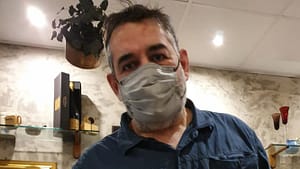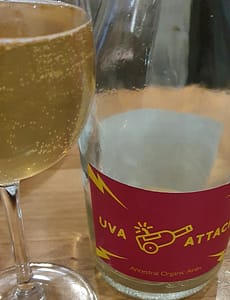No trip to Madrid is complete without a visit to Carlos Campillo’s Cascorro Bistrot. Located by the Plaza de Cascorro where the Rastro market are held on Sundays, it’s the place where Carlos Campillo currently stays. Carlos, with French background, has had several places of the bistro type including natural wines in Madrid. One of its predecessors can you read about here. He has also organized natural wine fairs in town.
This Sunday I started with an Uva Attack, the 2020 version of the ancestral. Carlos explains that Jesús Sánchez-Mateos Campo, the enologue of the coop Alcázar de San Juan in Ciudad Real has made this wine together with Ezequiel Sánchez Mateos, proprietor of the wine shop Reserva y Cata. They launch it under the brand Galdo Wines. Here it shows how fresh a sparkler from the grape airén can be: Light golden, somewhat cloudy; yellow apples, fennel; good acidity, citrusy mouthfeel, and a touch of lemongrass. A quite simple wine really, but appealing.
Las Pilas from Luís Oliván, was also in its 2020 vintage. It’s a quite dark garnacha with violet hints; dark fruits and licorice; juicy in the mouth, light-bodied with some tannin. It comes from the southwest of Somontano with abundant north wind. The wine rests up to six months in big, used barrels. I had it with duck confit.
Paeriza is a wine from Samuel Cano of Cuenca, a favourite of mine, and also a friend of the house. “es-carbó” as indicated on the label, gives allusions to snails, and maybe also low-carb. It’s a dark syrah with aromas of wild berries, herbs and a touch of aceton; lively in the mouth, with dark fruits all the way to the finish.
La Garulla 2019 from Bodega Honorato Callejo has “origen sin denominación” (origin without denomination), according to its label. In reality it has, even if no DO. Agricultural student Pablo and his father Honorato Calleja make it in Amusquillo de Esgueva. This is in the Esgueva valley that runs between the Duero and Pisuerga valleys, in western Ribera del Duero. By the way, they also have some grapes in Valbuena in the neighboring valley.
Pure tempranillo, it’s a dark cherry coloured wine with typical varietal aromas of red fruits and blackberries. Fresh and fruity in the mouth, with fine-grained tannins. The back label says fermented in barrique, but it has zero trace of this.
Samuel Cano’s aromatic, delicious pét-nat Micmac 2020 was served on the next day. Made of airen/moscatel, it showed light yellow (no notes of bubbles); pears and flowers on the nose. The bubbles are noted in the mouth, with good acidity and also some light varietal (moscatel) bitterness.
Leave a Comment














